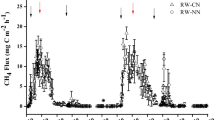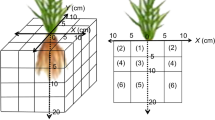Abstract
To identify the key soil parameters influencing CH4 emission from rice paddies, an outdoor pot experiment with a total of 18 paddy soils was conducted in Nanjing Agricultural University during the 2000 rice growing season. The seasonal average rate of CH4 emission for all 18 soils was 6.42±2.70 mg m−2 h−1, with a range of 1.96 to 11.06 mg m−2 h−1. Correlation analysis indicated that the seasonal average of CH4 emission was positively dependent on soil sand content and negatively on total N as well as NH4 +-N determined before rice transplanting. Copper content of soils had a significant negative impact on CH4 emission. No clear relationship existed between CH4 emission and soil carbon content. In addition, soil type cannot explain the variability in CH4 emission. Soil parameters influencing CH4 emission were different as rice growth and development proceeded. A further investigation suggested that the seasonal average rate of CH4 emission could be quantitatively determined by a linear combination of soil NH4 +-N, available copper, the ratio of available to total sulphur, and the ratio of available to total iron. Moreover, the average rates of CH4 emission in the vegetative, reproductive and ripening stages could be also respectively described by a linear combination of different soil variables.
Similar content being viewed by others
References
Bachelet D & Neue HU (1993) Methane emission from wetland rice areas of Asia. Chemosphere 26: 219–237
Bouwman AF (1991) Agronomic aspects of wetland rice cultivation and associated methane emissions. Biogeochemistry 15: 65–88
Cai Z, Shen G, Yan X, Tsuruta H, Yagi K & Minami K (1998) Effects of soil texture, soil temperature and Eh on methane emissions from rice paddy fields. ACTA PEDOLOGIA SINICA, 35(2): 145–154 (in Chinese with English abstract)
Cao M, Dent JB & Heal OW (1995) Modeling methane emission from rice paddies. Global Biogeochem Cycles 9: 183–195
Cicerone RJ, Oremland RS (1988) Biogeochemical aspects of atmospheric methane. Global Biogeochem Cycles 2: 299–327
Conrad R & Rothfuss F (1991) Methane oxidation in the soil surface layer of a flooded rice field and the effect of ammonium. Biol Fertil Soils 12: 28–32
Conrad R (1993) Mechanisms controlling methane emission from wetland rice fields. In: Oremland RS (ed) The Biogeochemistry of Global Change: Radiative Trace Gases, pp 317–335. Chapman & Hall, New York
Gerard G & Chanton J (1993) Quantification of methane oxidation in the rhizosphere of emergent aquatic macrophytes: defining upper limits. Biogeochemistry 23: 79–97
Holzapfel-Pschorn A, Conrad R & Seiler W (1986) Effects of vegetation on the emission of methane by submerged paddy soil. Plant Soil 92: 223–233
Houghton JT, Jenkins GJ & Ephraums JJ (1990) Climate Change: The IPCC Scientific Assessment. Cambridge University Press, New York
Huang Y, Sass RL & Fisher FM (1997a) Methane emission from Texas rice paddy soils. 1. Quantitative multi-year dependence of CH4 emission on soil, cultivar and grain yield. Global Change Biol 3(6): 479–490
Huang Y, Sass RL & Fisher FM (1997b) Methane emission from Texas rice paddy soils. 2. Seasonal contribution of rice biomass production to CH4 emission. Global Change Biol 3(6): 491–500
International Rice Research Institute (1989) IRRI Toward 2000 and Beyond. IRRI, Manila, Philippines
IPCC (2000) IPCC Good Practice Guidance and Uncertainty Management in National Greenhouse Gas Inventories. pp 4.77–4.94. IGES, Tokyo
Liu GS (1996) Soil Physical and Chemical Analysis & Description of Soil Profiles. Standards Press of China, Beijing, 266 pp (in Chinese)
National Soil Survey Office (1998) Soils of China, pp 712–728, China Agricultural Press, Beijing (in Chinese)
Neue HU & Roger PA (1993) Rice agriculture: factors controlling emissions. In: Khalil MAK (ed) Atmospheric Methane: Sources, Sinks, and Role in Global Change, pp 254–298. Springer-Verlag, New York
Neue HU, Latin RS, Wassmann R, Aduna JB, Alberto CR & Andales MJF (1994) Methane emission from rice soils of the Philippines. In: Minami K, Mosier A & Sass R (eds) CH4 and N2O: Global Emissions and Controls from Rice Fields and Other Agricultural and Industrial Sources, pp 55–63. YOKENDO Publishers, Tokyo
Nouchi I (1994) Mechanisms of methane transport through rice plants, In: Minami K, Mosier A & Sass R (eds) CH4 and N2O: Global Emissions and Controls from Rice Fields and Other Agricultural and Industrial Sources, pp 87–104. YOKENDO Publishers, Tokyo
Parashar DC, Rai J, Gupta PK & Singh N (1991) Parameters affecting methane emission from paddy fields. Ind J Radio Space Phys 20: 12–17
Rodhe H (1990) A comparison of the contribution of various gases to the greenhouse effect. Science 248: 1217–1219
Sass RL, Fisher FM & Harcombe PA (1990) Methane production and emission in a Texas rice field. Global Biogeochem Cycles 4: 47–68
Sass RL, Fisher FM, Lewis ST, Jund MF & Turner FT (1994) Methane emission from rice fields: effect of soil properties. Global Biogeochem Cycles 8: 135–140
Schütz H, Seiler W & Conrad R (1989) Processes involved in formation and emission of methane in rice paddies. Biogeochemistry 7: 33–53
Schütz H, Schröder P & Rennenberg R (1991) Role of plants in regulating the methane flux to the atmosphere. In: Sharkey TD, Holland EA & Mooney HA (eds) Trace Gas Emissions by Plants, pp 29–63. Academic Press, Inc., NY
Wassmann R, Neue HU, Bueno C, Lantin RS, Alberto MCR, Buendia LV, Bronson K, Papen H & Rennenberg H (1998) Methane production capacities of different rice soils derived from inherent and exogenous substrates. Plant Soil 203: 227–237
Xu X, Wang Y, Zheng X, Wang M, Wang Z, Zhou L & Van Cleemput O (2000) Methane emission from a simulated rice field ecosystem as influenced by hydroquinone and dicyandiamide. Sci Total Environ 263: 243–253
Yagi K & Minami K (1990) Effects of organic matter applications on methane emission from some Japanese paddy fields. Soil Sci Plant Nutr 36: 599–610
Yao H, Conrad R, Wassmann R & Neue HU (1999) Effect of soil characteristics on sequential reduction and methane production in sixteen rice paddy soils from China, the Philippines, and Italy. Biogeochemistry 47(3): 267–293
Yoshida S (1981) Fundamentals of Rice Crop Science, pp 33–34. IRRI, Manila
Author information
Authors and Affiliations
Rights and permissions
About this article
Cite this article
Huang, Y., Jiao, Y., Zong, L. et al. Quantitative dependence of methane emission on soil properties. Nutrient Cycling in Agroecosystems 64, 157–167 (2002). https://doi.org/10.1023/A:1021132330268
Issue Date:
DOI: https://doi.org/10.1023/A:1021132330268




